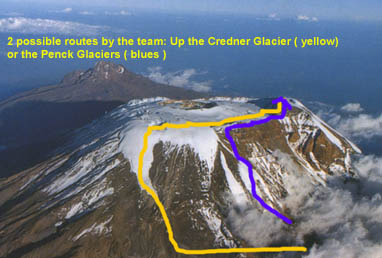
The Mountain, The Story, The Route, Special Thanks
Kilimanjaro is the highest mountain in Africa, located in northeast Tanzania, near the Kenya border. Kilimanjaro is an extinct volcano, and is one of the most massive in the world. It towers 5000m above the surrounding plains, and much of its surface is over 5500m Beneath its ice dome, snow extends down long gullies that have been eroded in the mountain sides. It was only ‘discovered’ by explorers from the west in 1848.
Kilimanjaro’s summit crater, known as Kibo, measures nearly one kilometre across. The highest point on Kibo’s steep rim is Uhuru, the highest peak in Africa, at 5895m. Deep in the center of Kibo is a smaller , 200m crater. The summit was successfully climbd for the first time in 1889 by Meye and Purtscheller.
David Lim, the project organiser, had the germ of an idea to undertake a climbing expedition with an all-disabled team of mountaineers in Oct 2000; subsequent to a UIAA General Assembly that he attended. The intention of the climb was to highlight the abilities, rather than the disabilities of people burdened with handicaps.
The project moved along with members invited and objectives sifted through. Ultimately, an unsupported climb on one of Kilimanjaro’s remote northern icefields was selected. Very few recorded ascents are known and almost no information on these routes are available online. The ascent was to have taken place in Jan 2003 but personal issues in the team led to the project postponed by another year.
The team will rendezvous in Nairobi, with Jamie Andrew flying from Britain and the rest of the team from Tasmania and Singapore.
The team will take a route via the Shira Plateau in the direction of the Arrow Glacier/ Western Breach area. This is part of the classic Shira route. A total of 9 climbing days have been allocated ( versus the usual six days ) to allow for route-finding and the fact that members of the climbing team are disabled. The team hopes to climb unsupported on the final four days from the terminus of either the Penck Glacier systems or the Credner Glacier. See the possible route options above.
The team thanks Doug Hardy, Ph.D. of the Dept. of Geosciences, Morrill Science Center, University of Massachusetts for invaluable information on the conditions and potential routes in the northern icefield areas.